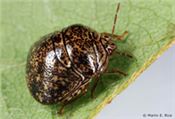|
Kudzu Bugs Spread To 7 Counties In Arkansas: Too Late To Damage State’s Soybeans

This tiny kudzu bug has caused big problems for soybean growers across the South.
Image courtesy Marlin E. Rice, Pioneer Seed
FAYETTEVILLE, ARK.
Poinsett is the latest county to see kudzu bugs, bringing the number of Arkansas counties in which the pest has spread to seven.
Nick Seiter, University of Arkansas System Division of Agriculture entomologist, said kudzu bugs have been found in several soybean fields in Crittenden County, the first location where they were found in the state.
Russell Parker, interim staff chair for the Crittenden County Extension Office, said he found the pests in three kudzu patches in 2014. In 2015, they began showing up in soybean fields.
“When they reach a threshold level in kudzu, they begin to move out into other legumes, especially soybeans,” Parker said. “We’ve been monitoring them pretty closely, and nearly all the crop consultants in the county have seen kudzu bugs in soybeans.”
Parker noted that kudzu bugs in soybeans have not reached threshold levels for which the extension service would recommend pesticide treatments.
Single kudzu bugs have been found in soybeans in Mississippi and Lee counties this year, Seiter said. In the remaining four counties – Ashley, Saint Francis, Phillips and Poinsett – the insects have been found only in kudzu patches.
Robert Goodson, Phillips County extension agricultural agent, said the pests showed up in early October, but have only been seen in kudzu patches. He noted that one did crawl across his desk but he’d just come in from the field and it probably rode back to the office with him.
“So far, we’ve only collected specimens for educational purposes, to show farmers what to look for,” Goodson said.
“As few as there are this year, we probably won’t have much trouble with them in 2016,” Goodson said. “But they may be a problem in 2017.”
It’s too late in the year for the pests to do much damage to the state’s soybean crop, Seiter said.
“Kudzu bugs have not been found at the recommended treatment threshold of one nymph per sweep in soybeans in Arkansas,” Seiter said. “To our knowledge, no insecticide applications have gone out for kudzu bugs.”
“Most soybean fields in Arkansas are far enough along that treatment-level populations are unlikely to occur this year,” Seiter said, “but growers should be vigilant going into 2016 as the distribution of the kudzu bug continues to expand.”
“We do think we’ll find a few soybean fields next year that will need to be treated,” Seiter said.
Growers should scout their fields with sweep nets, just as they would for other insect pests, Seiter said. The threshold level to treat for kudzu bugs is an average of one per sweep. For example, the threshold for treatment is reached if a total of 25 kudzu bugs are counted after 25 sweeps of the net.
That’s a pretty high threshold, Seiter said. “It takes quite a few kudzu bugs to do damage to a soybean crop.”
Seiter said it typically takes the pests one to two years to establish a population density in a new area that is high enough to become a problem for farms. He said the kudzu bugs’ spread nationwide has slowed a little this year, so it may take a little longer for them to establish that population level.
Kudzu bugs were first seen in Arkansas in 2014, and only in Crittenden County that year. ∆
|
|